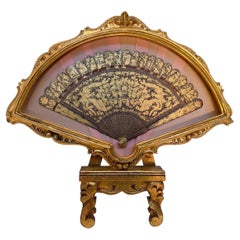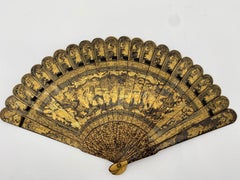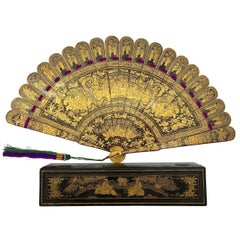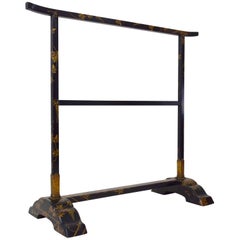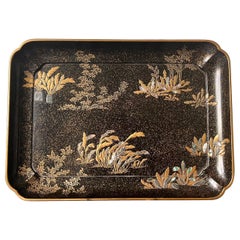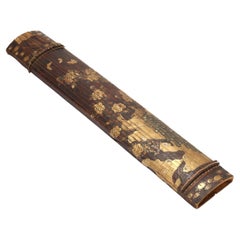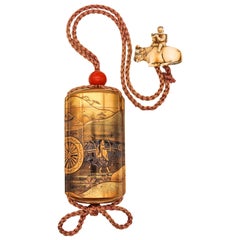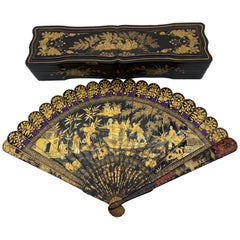1830s Lacquer
to
4
4
86
312
192
10
103
50
13
10
1
12
8
1
4
3
3
4
4
4
3
1
4
4
4
Period: 1830s
Antique Chinese Hand Paint Gold Lacquer Scene Gilt Fan
Located in Brea, CA
19th Century antique Chinese hand painted gold lacquer scene gilt fan 100 faces with original wood case and stand, fan is 13 inch x 8 '', the fan in ...
Category
Chinese Qing Antique 1830s Lacquer
Materials
Lacquer
Antique Chinese Hand Painted Lacquer Scene Gilt Fan with Lacquer Box
Located in Brea, CA
19th century antique Chinese hand painted lacquer scene gilt fan with original lacquer box.
Category
Chinese Qing Antique 1830s Lacquer
Materials
Lacquer
Antique Chinese Hand Paint Gold Lacquer Scene Gilt Fan with Lacquer Box
Located in Brea, CA
19th century antique Chinese hand painted gold lacquer scene gilt fan 100 faces with original lacquer box, fan is 17 inch x 9.5 x 1, the lacquer fan box is 10....
Category
Chinese Qing Antique 1830s Lacquer
Materials
Lacquer
Elegant Japanese Edo Period Rack
Located in New York, NY
This refined object dates to the first half of the 19th century, and was probably used for obi, kimono sashes, which were hung over it. The gold decorations on the black-lacquered g...
Category
Japanese Edo Antique 1830s Lacquer
Materials
Lacquer
Related Items
Japanese Lacquer Tray with Maki-e and Inlay Hara Yoyusai Edo Period
Located in Atlanta, GA
A lovely Japanese lacquer rectangular lacquer tray with a slightly scalloped corner and four L shape supporting feet by one of the most celebrated lacquer artist active in Edo period Hara Yoyusai (1772-1845). Yoyusai lived in Edo (Tokyo) and worked under the patronage of Lord Matsudaira. He operated a large workshop and had a very prolific output of lacquer objects. Most survived pieces being inro...
Category
Japanese Japonisme Antique 1830s Lacquer
Materials
Wood, Lacquer
$8,000
H 1.5 in W 11.5 in D 8.25 in
Japanese Meiji Han Koto with Maki-e Lacquer Decoration
Located in Atlanta, GA
A rare Japanese Koto made from carved Paulownia wood and lavishly decorated with lacquer Maki-e circa late 19th century of Meiji Period (1868-1912). The ...
Category
Japanese Japonisme Antique 1830s Lacquer
Materials
Wood
Exquisite Japanese Lacquer Maki-e Suzuribako by Koma Kyūhaku Edo Period
Located in Atlanta, GA
One of the finest Japanese Maki-e Suzuribakos (ink box) we have on offer, the roiro color box showcases an ambient nocturnal scene in which two shakudo inlaid crows perched on the handrails of a bridge (possible the Uji Bridge...
Category
Japanese Japonisme Antique 1830s Lacquer
Materials
Stone, Metal
$18,000
H 2 in W 9.25 in D 10.125 in
Edo Maki-e Japanese Box
Located in Brescia, IT
Japanese box with lacquer lid finely decorated with Maki-e, dating from the 18th century, mid-Edo period.
The box is of special size to preserve important calligraphy.
All sides of ...
Category
Japanese Edo Antique 1830s Lacquer
Materials
Gold Leaf
Japanese Antique Lacquer Hair Comb with Flowers in Gold Maki-e
Located in New York, NY
Stunning antique Japanese lacquer hair comb with a geometric petal-like background of stylized chrysanthemums and flowers done in gold and red maki-e. Possibly Edo or Meiji time peri...
Category
Japanese Antique 1830s Lacquer
Materials
Giltwood, Lacquer
Japanese Lacquer Smoking Box, Tabako Bon, Edo Period, 19th Century
Located in Austin, TX
A very fine Japanese maki-e lacquer decorated tabako bon, or smoking box, late Edo Period, mid-19th century, Japan.
The elegant smoking box of black lacquer decorated with a wonderful gold lacquer takamaki-e design of a gnarled and elegantly twisted plum tree with branches in full bloom. A border of golden cranes in flight to the top.
The smoking box, called a tabako bon, is comprised of an open section at the top with inset with two cylindrical metal canisters...
Category
Japanese Edo Antique 1830s Lacquer
Materials
Lacquer
Japanese Lacquer and Cinnabar "Samurai" Cabinet, Inaba Family, Edo Period
Located in Troy, NY
Exceptionally large and rare lacquer cabinet. According to the heraldry, visible on the headgear in one of the panels, it was made for the Inaba family, a high ranking Daimyo family,...
Category
Japanese Edo Antique 1830s Lacquer
Materials
Wood
$385,000
H 38 in W 36 in D 21 in
Japanese Lacquer Incense Accessories Box, Kobako, Edo Period, mid 19th c, Japan
Located in Austin, TX
A remarkable Japanese maki-e lacquer box for incense accessories, kobako, with interior fitted tray, kakego, designed with a temple complex scene, late Edo Period, mid 19th century, ...
Category
Japanese Edo Antique 1830s Lacquer
Materials
Silk, Softwood, Cypress, Lacquer
$8,500
H 3.75 in W 7.25 in D 5.5 in
Antique Chinoisiere Lacquered Box
Located in New York, NY
Chinoiserie Lacquer Box. Beautifully hand painted Chinoiserie Box decorated with auspicious Chinese scenes. The box is constructed of wood having polychrome painting lacquered with...
Category
Chinese Qing 1830s Lacquer
Materials
Bronze
Antique Japanese Inro by Shigehide Edo Period
Located in Atlanta, GA
This exquisite four-case lacquered inro was dated to the latter part of 18th century to early 19th century (Edo period) and made by Shigehide. The opposite sides of the inro together features a lavish flower arrangement in a bamboo basket (ikebana). The detailed craftmanship was a true pleasure to behold. Mostly Takamaki-e (high relief) were used to texturize the delicate petals of the chrysanthemums, on which different shades of gold were used to create contrast. Raden (mother of pearl) shells were also used to highlight some leaves, rendering the piece an interesting balance of color and material. The interior was completed in a mottled gold finish. It was signed Shigehide on the bottom with a Kao. There is a small carved rabbit ojime bead...
Category
Japanese Japonisme Antique 1830s Lacquer
Materials
Wood, Lacquer
Chinese Vintage Black Lacquer Game Box with Gilded Traditional Landscape Scenes
Located in Yonkers, NY
A Chinese vintage lacquer game box from the mid 20th century, with gold leaf hand-painted landscape and floral décor. Created in China during the midcentury period, this vintage game box features a black lacquer ground perfectly accented with gilded hand-painted traditional landscapes and pagodas. The circular body, flanked with straight splaying supports, is topped with a lid revealing the small storage space. With its elegant lines and complimenting colors, this vintage Chinese game box...
Category
Chinese 1830s Lacquer
Materials
Wood
$1,100
H 18 in Dm 16.5 in
Japanese Lacquer Incense Burner, Koro, Edo period, mid 19th century, Japan
Located in Austin, TX
An elegant and refined Japanese lacquer koro, incense burner, in the form of a chaire, tea caddy, Edo Perio, mid 19th century, Japan.
The barrel shaped koro formed as a traditional ...
Category
Japanese Edo Antique 1830s Lacquer
Materials
Copper
$1,250
H 2.88 in Dm 2.44 in
Previously Available Items
Japan 1830 Edo Period Six Drawer Inro In Lacquered Gilt Wood With A Carriage
Located in Miami, FL
Japanese Inro from the Edo Period (1603-1867).
Beautiful Inro, created in Japan during the Edo period (Shogunate), circa 1830. It was carefully crafted in carved precious wood with applications of lacquer and decorated with orientalism patterns. All dan trays are attached together with a himo cord. The detailed craftsmanship was a true pleasure to behold.
Period: Edo 1606-1867, Shogunate.
Approximate Date: 1830
Motif: An elaborated three-dimensional royal carriage with a silvered bull and a richly dressed court companion. All surrounded by a road and sinuous mountainous landscape with trees and plants.
Drawers: Six.
Shape: Oval
Technique: Carved wood, Lacquer, hiramaki-e, takamaki-e, Gilding, Silvered.
Ojime: 15mm, round sphere carved from natural translucent carnelian
Netsuke: Patinated carved seated child playing a shakuhachi (flute) in a resting bull, signed.
Weight: 67.60 Grams.
Measurements: Inro is 92 mm by 27 mm by 38 mm (3.60 x 1.06 x 1.50 Inches).
The Edo Period
The Edo period or Tokugawa period is the period between 1603 and 1867 in the history of Japan, when Japan was under the rule of the Tokugawa shogunate and the country's 300 regional daimyo. Emerging from the chaos of the Sengoku period, the Edo period was characterized by economic growth, strict social order, isolationist foreign policies, a stable population, perpetual peace, and popular enjoyment of arts and culture. The period derives its name from Edo (now Tokyo), where on March 24, 1603, the shogunate was officially established by Tokugawa Ieyasu. The period came to an end with the Meiji Restoration and the Boshin War, which restored imperial rule to Japan. The Tokugawa (or Edo) period brought 250 years of stability to Japan. The political system evolved into what historians call bakuhan, a combination of the terms bakufu and han (domains) to describe the government and society of the period.[3] In the bakuhan, the shōgun had national authority and the daimyo had regional authority. This represented a new unity in the feudal structure, which featured an increasingly large bureaucracy to administer the mixture of centralized and decentralized authorities. The Tokugawa became more powerful during their first century of rule: land redistribution gave them nearly seven million koku, control of the most important cities, and a land assessment system reaping great revenue
Inro
Is a traditional Japanese case for holding small objects, suspended from the obi (sash) worn around the waist when wearing a kimono. They are often highly decorated with various materials such as lacquer and various techniques such as maki-e, and are more decorative than other Japanese lacquerware. Because traditional Japanese dress...
Category
Japanese Edo Antique 1830s Lacquer
Materials
Gold, Silver
H 3.6 in W 1.5 in D 1.06 in
Antique Chinese Hand Painted Lacquer Scene Gilt Fan with Lacquer Box
Located in Brea, CA
19th century antique Chinese hand painted lacquer scene gilt fan with original lacquer box.
Category
Chinese Qing Antique 1830s Lacquer
Materials
Lacquer
19th Century Chinese Hand Painted Lacquer Export Fan Even-Tail
Located in Brea, CA
Very large antique 19th century Chinese hand painted lacquer export fan even-tail from the Qing Dynasty.
Category
Chinese Qing Antique 1830s Lacquer
Materials
Lacquer
Chinese Lacquered Sign
Located in Chicago, IL
During the Qing Dynasty there were seven levels of government. This sign indicates the title "Rong Deng Guo Zhang," which represents the first level, that of a prime minister. The hi...
Category
Chinese Antique 1830s Lacquer
English Faux Bamboo Black Lacquered Writing Desk, Circa 1830
Located in Charleston, SC
English faux bamboo black lacquered four-drawer writing desk with stage gallery, cross stretchers, stenciled bird and floral motif and terminating on splayed bamboo legs, Early 19th ...
Category
British George IV Antique 1830s Lacquer
Recently Viewed
View AllMore Ways To Browse
Large Japanese Lacquer Box
Meiji Japan Tray
Lacquered Japanese Bowl
Japanese Comb
Japanese Lacquered Miniature
Japanese Red Lacquer Tray
Japanese Lacquer Plaque
Large Cinnabar
Chinese Carved Cinnabar Red Lacquer
Korean Mother Of Pearl Furniture
Korean Mother Of Pearl
Japanese Lacquer Ware
Antique Chinese Cinnabar Lacquer
Japanese Lacquered Trunk
Chinese Red Lacquer Tray
Red Lacquer Ware
Burmese Lacquer Trays
Japanese Makie Lacquer
